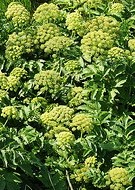 This native of Europe and Asia has a long history rich with folklore and myth but it is also a striking garden plant. Growing 5-8 feet all, it commands attention at the back of the border or as a specimen plant. The round hollow stem is divided into many branches that bear large globe-shaped clusters of tiny white or greenish fragrant flowers in mid summer. The leaves are divided and each oval leaflet is toothed. The plant is biennial or perennial depending on how you grow it. It dies after producing one crop of seed usually done in the second or third year. If you keep the plant from blooming it will last for several years.
This native of Europe and Asia has a long history rich with folklore and myth but it is also a striking garden plant. Growing 5-8 feet all, it commands attention at the back of the border or as a specimen plant. The round hollow stem is divided into many branches that bear large globe-shaped clusters of tiny white or greenish fragrant flowers in mid summer. The leaves are divided and each oval leaflet is toothed. The plant is biennial or perennial depending on how you grow it. It dies after producing one crop of seed usually done in the second or third year. If you keep the plant from blooming it will last for several years.
Angelica is a tasty plant and leaves, root, stem, and seed all have a licorice flavor that can be used in many dishes including soups, stews, desserts, and breads. The stem is often candied and eaten alone or used to decorate cakes and other sweets. The dried leaves can be used to brew a pleasant tea and the seeds and roots are used to flavor liqueurs such as Benedictine and Chartreuse. Various parts of the plant are used to treat digestive and bronchial problems but the effectiveness of angelica has yet to be proven and some scientists are concerned about its carcinogenicity. Another warning: angelica looks very much like water hemlock, Cicuta maculata, a plant that is extremely toxic so gathering angelica from the wild for medicinal or culinary use is very dangerous unless you are an expert on the plant.
Type: Biennial herb
Bloom: Tiny greenish to white, fragrant flowers are produced in umbels in mid summer
Foliage: Pinnateley compound leaves with oval leaflets 1-3” long
Size: 5-8’ H x 4’W
Light: Partial shade
Soil: Rich, moist, well drained, pH 6.3
Fertilizer: Apply complete fertilizer in spring.
Hardiness: Zones 4-9
Care: Harvest roots in the all of the first year; stems and leaves in the spring of the second year; seeds when ripe.
Pests and Diseases: Susceptible to spider mites, leaf miners, earwigs, and aphids; crown rot may develop in wet summers.
Propagation: Seed (need light to germinate so do not cover when planting)
Companion Plants: Purple vervain (Verbena bonariensis), giant scabiosa (Cephalaria gigantean) and meadow rue (Thalictrum).
